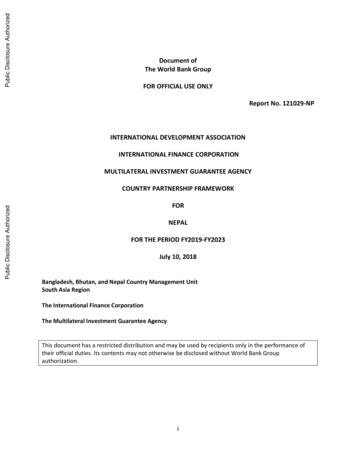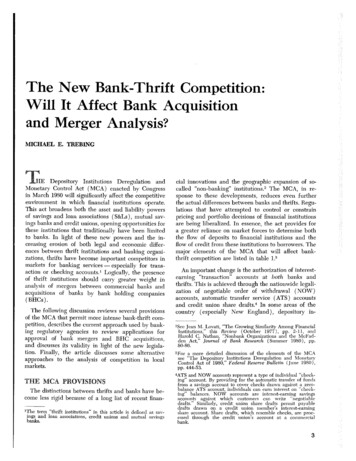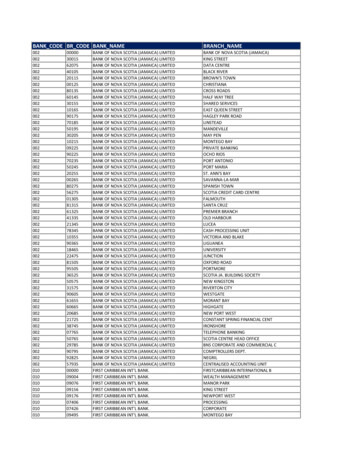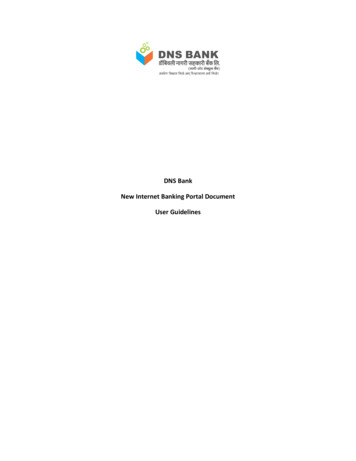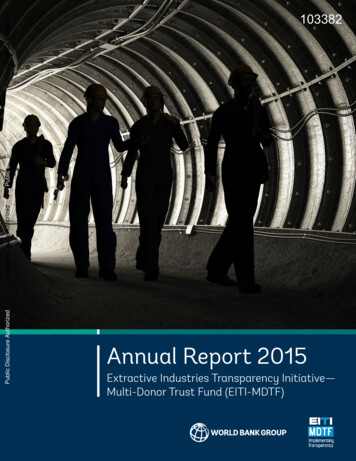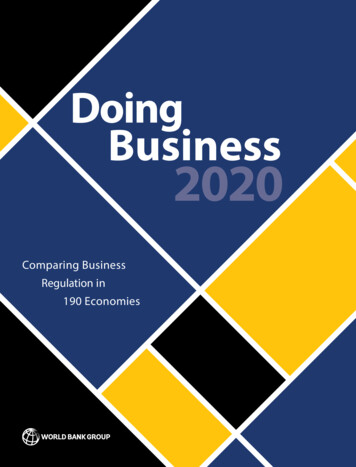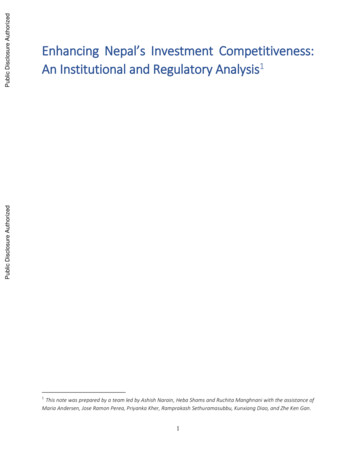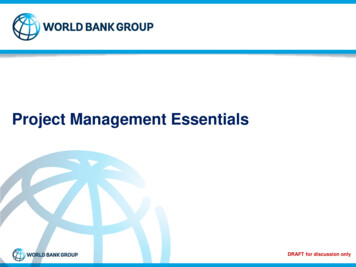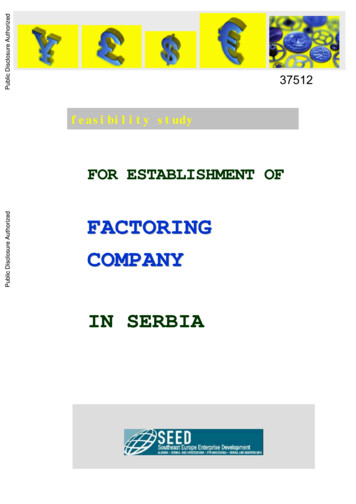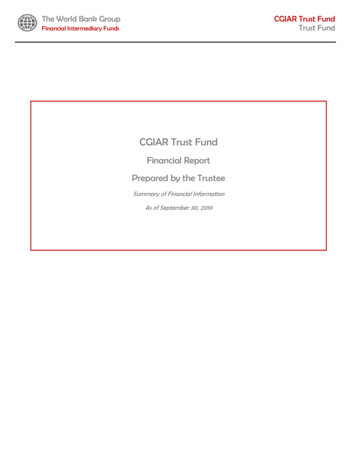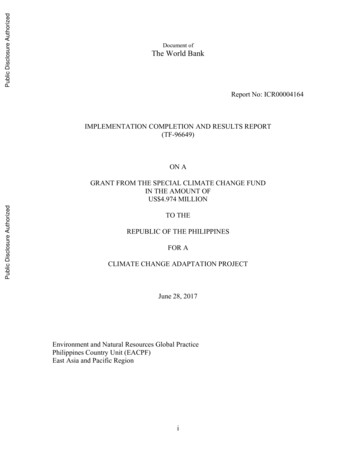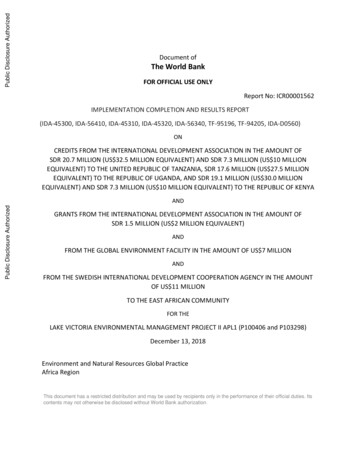
Transcription
Public Disclosure AuthorizedDocument ofThe World BankFOR OFFICIAL USE ONLYPublic Disclosure AuthorizedReport No: ICR00001562IMPLEMENTATION COMPLETION AND RESULTS REPORT(IDA-45300, IDA-56410, IDA-45310, IDA-45320, IDA-56340, TF-95196, TF-94205, IDA-D0560)ONCREDITS FROM THE INTERNATIONAL DEVELOPMENT ASSOCIATION IN THE AMOUNT OFSDR 20.7 MILLION (US 32.5 MILLION EQUIVALENT) AND SDR 7.3 MILLION (US 10 MILLIONEQUIVALENT) TO THE UNITED REPUBLIC OF TANZANIA, SDR 17.6 MILLION (US 27.5 MILLIONEQUIVALENT) TO THE REPUBLIC OF UGANDA, AND SDR 19.1 MILLION (US 30.0 MILLIONEQUIVALENT) AND SDR 7.3 MILLION (US 10 MILLION EQUIVALENT) TO THE REPUBLIC OF KENYAPublic Disclosure AuthorizedANDGRANTS FROM THE INTERNATIONAL DEVELOPMENT ASSOCIATION IN THE AMOUNT OFSDR 1.5 MILLION (US 2 MILLION EQUIVALENT)ANDFROM THE GLOBAL ENVIRONMENT FACILITY IN THE AMOUNT OF US 7 MILLIONANDFROM THE SWEDISH INTERNATIONAL DEVELOPMENT COOPERATION AGENCY IN THE AMOUNTOF US 11 MILLIONPublic Disclosure AuthorizedTO THE EAST AFRICAN COMMUNITYFOR THELAKE VICTORIA ENVIRONMENTAL MANAGEMENT PROJECT II APL1 (P100406 and P103298)December 13, 2018Environment and Natural Resources Global PracticeAfrica RegionThis document has a restricted distribution and may be used by recipients only in the performance of their official duties. Itscontents may not otherwise be disclosed without World Bank authorization.
The World BankAFCC2/RI-Lake Victoria Environmental Management Project II ( P100406 )CURRENCY EQUIVALENTSExchange Rate Effective December 31, 2017Currency Units: Special Drawing Rights (SDR)SDR 1 US 1.417FISCAL YEARJuly 1 - June 30ABBREVIATIONS AND RAdditional FinancingAfrican Development BankAdaptable Program LoanBeach Management UnitBenefit/CostBiological Oxygen DemandCountry Assistance StrategyCost-Benefit AnalysisCommunity-Driven DevelopmentCost-Effectiveness AnalysisCounty Integrated Development PlansCommunity Management InitiativeChemical Oxygen DemandCountry Partnership FrameworkCountry Partnership StrategyEnvironmental AssessmentEast African CommunityEnvironmental and Natural Resources ManagementEnvironmental and Social Impact AssessmentEnvironment and Social Management FrameworkFish Levy Trust FundFinancial ManagementFisheries Management PlanGross Domestic ProductGlobal Environment FacilityGlobal Environmental ObjectiveGeographic Information SystemImplementation Completion and Results ReportIndependent Evaluation GroupInternal Rate of Return
The World BankAFCC2/RI-Lake Victoria Environmental Management Project II ( P100406 tation Status and Results ReportKampala Capital City AuthorityKenya National Cleaner Production CentreLeather Industries of UgandaLocal Government AuthorityLake Victoria BasinSectoral Council of Ministers for Lake Victoria BasinLake Victoria Basin CommissionFirst Lake Victoria Environmental Management ProjectSecond Lake Victoria Environmental Management ProjectLake Victoria Fisheries OrganizationMonitoring and EvaluationManagement Information SystemMidterm ReviewNordic Development FundNational Project Coordination TeamNet Present ValueNational Policy Steering CommitteeNational Technical Steering CommitteeOperation and MaintenanceProject Appraisal DocumentProject Development ObjectiveResettlement Action PlanResource Efficient and Cleaner ProductionResults FrameworkRegional Project Coordination TeamRegional Policy Steering CommitteeSustainable Development GoalSwedish International Development Cooperation AgencySustainable Land ManagementStandard Operating ProtocolStrategic Investment ProgramSolid Waste ManagementTransboundary Diagnostic AnalysisTerms of ReferenceTask Team LeaderWater Resources Management PlanWater User Association
The World BankAFCC2/RI-Lake Victoria Environmental Management Project II ( P100406 )Regional Vice President: Hafez M. H. GhanemCountry Director: Paul Noumba UmSenior Global Practice Director: Karin KemperPractice Manager: Iain G. ShukerTask Team Leader(s): Jian Xie, Jane A. N. Kibbassa, Herbert OuleICR Main Contributor: Guoping Zhang
The World BankAFCC2/RI-Lake Victoria Environmental Management Project II ( P100406 )TABLE OF CONTENTSDATA SHEET . 1I.PROJECT CONTEXT AND DEVELOPMENT OBJECTIVES . 7A. CONTEXT AT APPRAISAL .7B. SIGNIFICANT CHANGES DURING IMPLEMENTATION . 18II.OUTCOME . 22A. RELEVANCE OF PDOs . 22B. ACHIEVEMENT OF PDOs (EFFICACY) . 23C. EFFICIENCY . 43D. JUSTIFICATION OF OVERALL OUTCOME RATING . 46E. OTHER OUTCOMES AND IMPACTS . 47III. KEY FACTORS THAT AFFECTED IMPLEMENTATION AND OUTCOME . 50A. KEY FACTORS DURING PREPARATION . 50B. KEY FACTORS DURING IMPLEMENTATION . 52IV. BANK PERFORMANCE, COMPLIANCE ISSUES, AND RISK TO DEVELOPMENTOUTCOME . 54A. QUALITY OF MONITORING AND EVALUATION (M&E) . 54B. ENVIRONMENTAL SAFEGUARD, SOCIAL SAFEGUARD, AND FIDUCIARY COMPLIANCE . 57C. BANK PERFORMANCE . 59D. RISK TO DEVELOPMENT OUTCOME . 61V. LESSONS LEARNED AND RECOMMENDATIONS . 62ANNEX 1. RESULTS FRAMEWORK AND KEY OUTPUTS . 65ANNEX 2. BANK LENDING AND IMPLEMENTATION SUPPORT/SUPERVISION . 90ANNEX 3. PROJECT COST BY COMPONENT. 94ANNEX 4. EFFICIENCY ANALYSIS . 97ANNEX 5. BORROWER, CO-FINANCIER, AND OTHER PARTNER/STAKEHOLDERCOMMENTS . 108ANNEX 6. SUPPORTING DOCUMENTS . 110ANNEX 7. LVEMP II APL 1 AND APL 2 MAP . 111
The World BankAFCC2/RI-Lake Victoria Environmental Management Project II ( P100406 )DATA SHEETBASIC INFORMATIONProduct InformationProject IDProject NameP100406Lake Victoria Environmental Management Project II APL1CountryFinancing InstrumentAfricaInvestment Project FinancingOriginal EA CategoryRevised EA CategoryFull Assessment (A)Full Assessment (A)Related ProjectsRelationshipProjectApprovalProduct LineAdditional FinancingP153466-AFFC2/RI-LakeVictoria EnvironmentalManagement ProjectAPL-1 AFP103298-AFCC2/RILake VictoriaEnvironmentalManagement Project II26-May-2015IBRD/IDA03-Mar-2009Global Environment ProjectSupplementOrganizationsBorrowerImplementing AgencyEast African Community, The United Republic ofTanzania, The Republic of Uganda, and The Republic ofKenyaTanzania Ministry of Water and Irrigation, UgandaMinistry of Water and Environment, Kenya Ministry ofEnvironment and Mineral Resources, Lake Victoria BasinCommission (LVBC)Page 1 of 111
The World BankAFCC2/RI-Lake Victoria Environmental Management Project II ( P100406 )Project Development Objective (PDO)Original PDOThe Project Development/Global Environmental Objectives (PDO/GEO) are to (i) improve collaborativemanagement of the transboundary natural resources of Lake Victoria basin for the shared benefits of the PartnerStates; and (ii) reduce environmental stress in targetted pollution hotspots and selected degraded sub-catchmentsto improve the livelihoods of communities, who depend on the natural resources of LVB.Revised PDOThe objectives of the project are to contribute to (i) the improvement of the collaborative management of thetransboundarynatural resources of the LVB among the Partner States; and (ii) the improvement of environmentalmanagement oftargeted pollutionhotspots and selected degraded sub-catchments for the benefit of communitieswho depend on the natural resourcesof LVB.PDO as stated in the legal agreementOriginal: The Project Development/Global Environmental Objectives (PDO/GEO) are to (i) improve collaborativemanagement of the transboundary natural resources of Lake Victoria basin for the shared benefits of the PartnerStates; and (ii) reduce environmental stress in targetted pollution hotspots and selected degraded sub-catchmentsto improve the livelihoods of communities, who depend on the natural resources of LVB.Revised: The objectives of the project are to contribute to (i) the improvement of the collaborativemanagement of the trans-boundary natural resources of the LVB among the Partner States; and (ii) theimprovement of environmental management of targeted pollution hotspots and selected degraded subcatchments for the benefit of communities who depend on the natural resources of the LVB.Page 2 of 111
The World BankAFCC2/RI-Lake Victoria Environmental Management Project II ( P100406 )FINANCING 1Original Amount (US )Revised Amount (US )Actual Disbursed (US )World Bank 9,179Bridge Financing TFs 00,00028,813,655P100406TF-95196 rld Bank FinancingTotal Project CostThe original system-generated datasheet was showing incorrect borrower contributions and was double-counting the Sidagrant (see footnote 3). This version of the financing data has been updated to reflect the correct amounts and references.12A Multi-Donor Trust Fund was set up during project preparation for bridging the activities between LVEMP-I and LVEMP-II.The Swedish International Development Cooperation Agency (Sida) provided SEK 80 million equivalent which was disbursed inseveral tranches over time. The initial transfer was US 8,655,071. The total amount disbursed was US 11,083,090. The PADrefers to US 10 million since the exact amount was not known at the time when the project was presented to the World Bank’sBoard of Executive Directors. The Sida Trust Fund Agreement was signed after the project was approved, applying the SEK/US exchange rate at the time of signing and each subsequent transfer.3Page 3 of 111
The World BankAFCC2/RI-Lake Victoria Environmental Management Project II ( P100406 )KEY DATESProjectApprovalEffectivenessMTR ReviewOriginal ClosingActual 6-Aug-2015n/a31-Dec-201731-Dec-2017RESTRUCTURING AND/OR ADDITIONAL FINANCING20-Jun-2012Amount Disbursed (US e(s)Key RevisionsChange in Project Development ObjectivesChange in Results FrameworkChange in Components and CostChange in Loan Closing Date(s)Change in Legal CovenantsChange in Implementation ScheduleReallocation between Disbursement CategoriesAdditional FinancingChange in Components and CostChange in Loan Closing Date(s)KEY RATINGSOutcomeBank PerformanceM&E QualityModerately UnsatisfactoryModerately UnsatisfactoryModestRATINGS OF PROJECT PERFORMANCE IN ISRsActualDisbursements(US , millions)No.Date ISR ArchivedDO RatingIP Rating0112-Dec-2009Moderately SatisfactoryModerately Satisfactory4.860212-Jun-2010Moderately SatisfactoryModerately Satisfactory10.380326-Mar-2011Moderately SatisfactoryModerately Unsatisfactory11.100429-Nov-2011Moderately SatisfactoryModerately Unsatisfactory15.95Page 4 of 111
The World BankAFCC2/RI-Lake Victoria Environmental Management Project II ( P100406 )0505-Jun-2012Moderately SatisfactoryModerately Unsatisfactory20.950614-Jan-2013Moderately SatisfactoryModerately Satisfactory31.050715-Sep-2013Moderately SatisfactoryModerately Satisfactory39.080829-Apr-2014Moderately SatisfactoryModerately rySatisfactory105.33SECTORS AND THEMESSectorsMajor Sector/Sector(%)Agriculture, Fishing and Forestry21ForestryWater, Sanitation and Waste ManagementSanitationPublic Administration - Water, Sanitation and WasteManagementOther Water Supply, Sanitation and WasteManagementThemesMajor Theme/ Theme (Level 2)/ Theme (Level 3)2179321829(%)Page 5 of 111
The World BankAFCC2/RI-Lake Victoria Environmental Management Project II ( P100406 )Urban and Rural Development35Urban Development15Urban Infrastructure and Service Delivery15Rural Development20Land Administration and Management20Environment and Natural Resource Management65Environmental Health and Pollution Management15Air quality management5Water Pollution5Soil Pollution5Renewable Natural Resources Asset Management10Biodiversity5Landscape Management5Water Resource Management40Water Institutions, Policies and Reform40Private Sector Development100Jobs100ADM STAFFRoleAt ApprovalAt ICRRegional Vice President:Obiageli Katryn EzekwesiliHafez M. H. GhanemCountry Director:Richard G. ScobeyPaul Noumba UmSenior Global Practice Director:Inger AndersenKarin Erika KemperPractice Manager:Marjory-Anne BromheadIain G. ShukerTask Team Leader(s):Ladisy Komba ChengulaJian Xie, Jane A. N. Kibbassa,Herbert OuleICR Contributing Author:Guoping ZhangPage 6 of 111
The World BankAFCC2/RI-Lake Victoria Environmental Management Project II ( P100406 )I. PROJECT CONTEXT AND DEVELOPMENT OBJECTIVESA. CONTEXT AT APPRAISAL1.The Lake Victoria Environmental Management Program II (LVEMP-II) was comprised of tworegional Adaptable Program Loans (APL, now replaced by a series of projects). The first of them, LVEMPII APL-1 4 covering the three riparian states (Kenya, Tanzania, and Uganda) and a regional coordination andpolicy component through the Lake Victoria Basin Commission (LVBC) of the East African Community(EAC), was implemented from 2009 to 2017 and is the subject of this Implementation Completion andResults Report (ICR). LVEMP II APL-2 (P118316, covering Rwanda and Burundi), was implemented from2012 to 2017 and is discussed in a separate ICR. 5 The APL lending instrument was selected at the time toenable Burundi and Rwanda to join the program once they met the eligibility criteria and policy andproject triggers and to allow for a phased approach to implement the longer-term program. 6Major Economic and Ecological Importance of Lake Victoria at Appraisal2.Lake Victoria and its basin are of major economic and ecological significance. The Lake VictoriaBasin (LVB) 7 is home to around 47 million inhabitants, with an estimated population density of 300persons per km2, one of the highest in the continent. Poverty is pervasive in the basin, at about 49 percentof the population of the LVB. 8 Most of the poor in the basin rely on natural resources for their livelihoods;for example, the income generated from fisheries provided food security and supported the livelihoodsof approximately 3 million people.9 Agriculture generates 30–40 percent of the regional gross domesticproduct (GDP). Over 80 percent of the LVB’s population rely on agricultural and livestock activities fortheir livelihoods and more than 60 percent depend on rain-fed agriculture. Large rural poor populationsare dependent on the degraded lands in the upper basin, particularly in Burundi, Rwanda, and the Kenyahighlands.3.The lake provides significant commercial fishing. According to the LVEMP-II APL1 PAD, thefisheries industry provided employment for about 197,000 fishers and approximately 600,000 fish tradersaround the lakeshore towns and cities. The fish resources provide foreign exchange earnings with anannual landed value of about US 300–400 million and combined export value of Nile perch estimated atThe Project Appraisal Document (PAD) title page simultaneously refers to “Phase I of the Adaptable Program Loan (APL)” and“Lake Victoria Environmental Management Project II” which initially created some confusion over the correct name of theproject and the words “phase” and “APL” seem to have been used interchangeably in various project documents. For thepurposes of this document, the project will be referred to as LVEMP-II APL-1.5 Report No: ICR00004335.6 According to the documents in the project files, the original project design envisaged LVEMP-II as a 10-15 year investment,consisting of three APLs: APL1 was to be up to 6 years, followed by a second APL that would include Rwanda and Burundi, andthen a third APL, still as part of LVEMP II, which was only outlined in broad terms in earlier versions of the PAD. The shorterduration of the initial APL1 was only 4 years, anticipating more financing to become available through the IDA replenishmentcycle.7 The LVB is roughly defined as the area within a 100-km radius from the lake shore. It covers a draining area of 194,200 Km2(LVBC 2007). Its population at the time of project appraisal was about 35 million inhabitants. In each country, the lake basinpopulation density was higher than its national average (Project Information Document, Report No.: AB3561).8 FAO 2008.9 LVEMP-II APL-1 PAD, World Bank 2009.4Page 7 of 111
The World BankAFCC2/RI-Lake Victoria Environmental Management Project II ( P100406 )US 250 million. The lake fishery contributions to the GDP of the riparian countries were 2 percent forKenya, 2.8 percent for Tanzania, and 3 percent for Uganda.4.Lake Victoria has been an important source of domestic industrial and irrigation water supplyand a source of drinking water to major urban centers. At the time of project appraisal, approximately 5million people living in the major cities and towns around the lake, such as Kampala, Entebbe, and Jinja(Uganda); Kisumu, Homa Bay, and Migori (Kenya); and Mwanza, Musoma, Bukoba, Shinyanga, andKahama (Tanzania), depended on Lake Victoria for their domestic and industrial water supply.5.The lake is also important to marine transport. Lake Victoria is navigable, providing a viable andcheap shipping and transportation route between and within the riparian countries. The main transportroutes include Mwanza - Port Bell/Jinja, Mwanza - Bukoba, Mwanza - Musoma, Port Bell/Jinja - Bukoba,and Kisumu - Bukoba, as well as numerous local networks. These marine routes are very important for theLVB countries’ trade and economic deve
refers to US 10 million since the exact amount was not known at the time when the project was presented to the World Bank’s Board of Executive Directors. The Sida Trust Fund Agreement was signed after the project was approved, applying the SEK/US exchange
